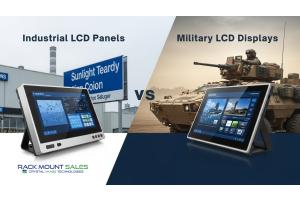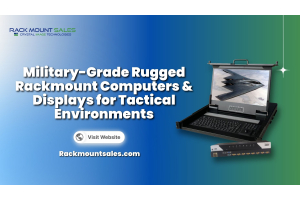Integration of Rack Mount LCD Panels with KVM Switches for Improved Server Management
Are you tired of managing your server room with clunky, outdated equipment? Look no further than the integration of rackmount LCD panels with KVM switches! These cutting-edge solutions provide a streamlined approach to server management. We will explore the benefits and how-to of integrating these technologies for improved efficiency and ease of use in this blog post. Say goodbye to the headache of managing your servers and hello to seamless integration with rackmount LCD panels and KVM switches!
Rackmount LCD Panels
Rackmount LCD Panels are essential tools for server management in data centers, server rooms, and other IT infrastructures. These panels provide a space-efficient solution that enables administrators to monitor servers at the rack level without having to physically access them. These panels come with various features such as high-definition displays, touchscreens, adjustable viewing angles, and compatibility with different types of KVM switches. They can be mounted on the front or back of server racks depending on your preference.
By eliminating the need for separate monitors and keyboards, these panels reduce clutter. This saves valuable rack space while providing a streamlined setup for better organization. Moreover, rackmount LCD Panels enhance security by limiting physical access to sensitive hardware components. In addition, they improve efficiency by providing faster response times during system maintenance or troubleshooting tasks. Rackmount LCD Panels are an excellent investment for businesses looking to optimize their server management capabilities.
KVM Switches
KVM switches are an essential tool for server management in data centers. KVM stands for Keyboard, Video, and Mouse, which are all devices that can be connected to a single KVM switch. This means that with the help of a KVM switch, multiple servers can be managed from one console. The basic function of a KVM switch is to allow users to access different servers from a single location. With the use of hotkeys or buttons on the switch itself, users can easily toggle between servers without having to physically move around or connect/disconnect cables.
Another advantage of using a KVM switch is that it eliminates clutter caused by multiple keyboards and mice on the work desk. Instead, all devices can be consolidated into one convenient location with easy access to all servers. Integrating a KVM switch with rackmount LCD panels provides an even more efficient way of managing servers as everything needed for server management is in one place - keyboard, video display, and mouse controls within reach at all times.
How do rackmount LCD panels improve server management?
Rackmount LCD panels have changed the way servers are managed. These panels offer an all-in-one server management solution with a monitor, keyboard, and mouse. They fit perfectly into server racks and save valuable space in data centers. One major benefit of rackmount LCD panels is their ease of use. They eliminate the need for extra cables and switches to connect servers to external monitors, keyboards, and mice. This simplifies the process of managing multiple servers from a single location.
Furthermore, they offer an efficient means of monitoring system status without physically accessing each individual component. The sleek design allows administrators to easily view critical information such as CPU usage, memory utilization, or other important metrics on one screen. In addition to that, rackmount LCD panels allow remote access to multiple systems through KVM (Keyboard-Video-Mouse) switches which provide secure access control enabling users instant connectivity with easy switching between connected devices.
How to integrate KVM switches with rackmount LCD panels
Integrating KVM switches with rackmount LCD panels is a straightforward process that can significantly improve server management. To start, ensure that the KVM switch and rackmount LCD panel are compatible and have matching ports.
Connect the video output from the KVM switch to the input port of the rackmount LCD panel using VGA or HDMI cables. Next, connect the USB and audio cables from both devices to allow for keyboard, mouse, and speaker control. It's important to set up any necessary drivers or software for your specific devices before attempting integration. Consult user manuals or online guides if needed.
Once connected, users can easily toggle between servers using buttons on their KVM switch while viewing all server activity on their attached rackmount LCD display. Integrating these two powerful tools will streamline server management while improving workflow efficiency and productivity in data centers around the world.
What are the benefits of integrating KVM switches with rackmount LCD panels?
Integrating KVM switches with rackmount LCD panels offer several benefits that make server management easier and more efficient. One of the benefits is space-saving, as it eliminates the need for multiple monitors and keyboards to manage servers. Another advantage is time-saving, as administrators can quickly switch between different servers without having to physically move from one device to another. This reduces downtime and increases productivity by allowing users to perform tasks simultaneously.
Additionally, integrating rackmount LCD panels with KVM switches offers enhanced security features such as password protection and remote access control. This ensures that only authorized personnel have access to critical systems while eliminating the risk of unauthorized access or data breaches. Moreover, KVM switches provide centralized management capabilities which allow administrators to monitor all connected devices from a single console. This helps in identifying issues early on and addressing them promptly before they turn into bigger problems that could cause significant downtime or system failures.
Future Trends and Emerging Technologies
As technology continues to advance, the future of server management is looking brighter. One emerging trend is the use of artificial intelligence (AI) in managing servers. With AI, tasks such as monitoring server performance and detecting potential problems can be automated. Another trend that's gaining popularity is the use of virtual reality (VR) for remote server management. Companies are developing VR interfaces that allow system administrators to visualize their servers in a virtual environment and perform maintenance tasks without physically being present.
In addition, edge computing is becoming more prevalent in server management. By bringing computing resources closer to where they're needed, this technology can reduce latency and improve overall performance.
Improved Server Management with Integrated Solutions
Improved server management is crucial for businesses that rely on their IT infrastructure to operate effectively. With an integrated solution of rackmount LCD panels and KVM switches, it becomes easier to manage servers efficiently.
Having a centralized console for all servers allows administrators to monitor the entire system from one location, reducing the need for physically going to each individual server. This saves time and reduces the risk of human error during maintenance activities.
Moreover, combining KVM switches with rackmount LCD panels enables users to control multiple computers at once. This eliminates clutter caused by numerous peripherals such as keyboards and mice which are replaced by a single set that can be controlled from the console.
Conclusion
As we have covered in this article, integrating rackmount LCD panels with KVM switches can greatly improve server management. rackmount LCD panels offer a space-saving solution for data centers and allow administrators to monitor multiple servers at once.
KVM switches provide remote access to servers without the need for physically accessing them, streamlining system administration tasks and reducing downtime. By combining these two technologies, administrators can enjoy a more efficient workflow that saves time and money while increasing productivity. Integrating these tools becomes increasingly important as data centers grow in size and complexity.
It's worth noting that there are also emerging technologies on the horizon that will further enhance server management capabilities. For example, AI-powered monitoring systems are being developed that use machine learning algorithms to detect anomalies before they become major issues.











